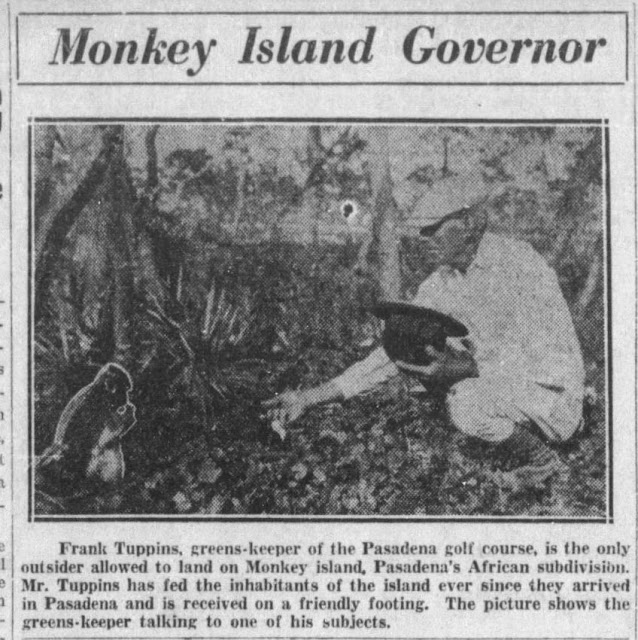More information about Jungle neighborhood monkeys has come to my attention...
 |
| 𝆕 Here we come... Walkin' down Park Street... We get the funniest looks... From everyone we meet...𝆕 |
Here are links to my previous Jungle monkey posts:
Monkeys Used to Swing in the Trees in the Jungle Neighborhood
Escape from Monkey Island: The True Story of the Jungle Neighborhood's Wild Monkeys
Monkeys Used to Swing in the Trees in the Jungle Neighborhood
Escape from Monkey Island: The True Story of the Jungle Neighborhood's Wild Monkeys
In February 1924, some "ring-tailed monkeys" were placed on Monkey Island near the 9th tee on the new Pasadena (Bear Creek) golf course. To be precise, the ring-tailed "monkey" ‒ as it was commonly referred to in the 1920's ‒ is a lemur. Lemurs are primates, an order that includes monkeys, apes and humans.
Over a period of months, the Monkey Island keepers introduced several different types of simians to the small island. Monkeys are known to fight for dominance and supremacy, so conflict was inevitable.
Over a period of months, the Monkey Island keepers introduced several different types of simians to the small island. Monkeys are known to fight for dominance and supremacy, so conflict was inevitable.
 |
| St. Petersburg Times December 5, 1925 |
By late 1926, the Florida land boom had collapsed and the developer, "Handsome Jack" Taylor abandoned his Pasadena sales office and laid off the staff. The monkeys on Monkey Island were neglected and left to fend for themselves.
 |
| St. Petersburg Times February 7, 1926 |
In January 1927, there was a big "free-for-all" fight between monkey groups on the island (St. Petersburg Times, Jan 21, 1927). The ring-tailed group swam across the lake, migrated about three miles north and hid in the Jungle neighborhood.
 |
| Ring-tailed lemurs. Source: pikist.com |
 |
| St. Petersburg Times November 27, 1927 |
This would seem to be the same family that Walter P. Fuller saw walking across his seawall at 450 Park Street North around that time. Fuller said the monkeys lived happily in the Jungle for several years.
 |
| Ring-tailed lemur. (Source Wikimedia Commons) |











